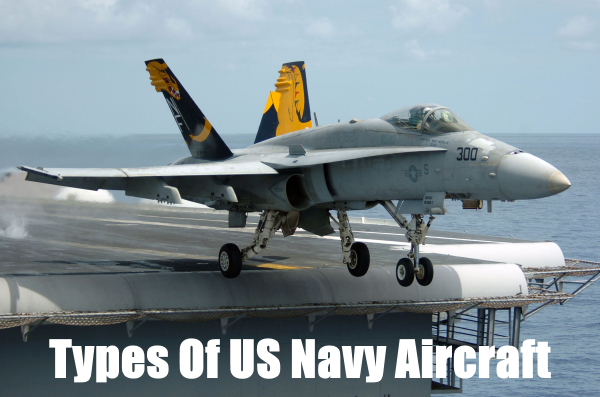The United States Navy manages an impressive lineup of aircraft and fighter jets in addition to its naval fleet.
There are many different types of Navy aircraft to learn about depending on what role it serves in the military.
For example, some Navy aircraft are designed for combat or transport roles.
Meanwhile, other Navy aircraft may specialize in complex procedures such as Airborne Early Warning (AEW) or Signals Intelligence (SIGINT).
Learn more about the different types of Navy aircraft/fighter jets – including 17 of the most iconic.
Related Article – 16 Types Of Military Helicopters Used By US Military
Table of Contents
Types of Navy Aircraft
The United States Navy relies on a substantial list of Navy aircraft in addition to its impressive naval fleet.
The average Navy carrier can accommodate 130 F/A-18 Hornets or nearly 100 mixed aircraft.
Thus, there is a high demand for U.S. Navy aircraft among some of the finest ships ever witnessed.
Today, the U.S. Navy relies on aircraft for a variety of purposes.
In fact, they are involved in search and rescue operations while often being first-response in combat situations.
Additionally, U.S. Navy aircraft plays a role in electronic warfare where modern planes are capable of jamming radar and other signals.
Furthermore, certain types of Navy aircraft provide the military branch with high-quality access to surveillance and reconnaissance.
The U.S. Navy has always maintained a competitive relationship with the rest of the military branches (and the world for that matter).
It all began after the U.S. Navy elected to produce its own aircraft (starting with the H-16 Patrol).
Therefore, the different types of Navy aircraft and fighter jets are unique to the branch:
- U.S. Navy Combat Planes
- Airborne Early Warning (AEW) Planes
- Radar Jamming Planes
- U.S. Navy Transport Planes
- VIP Transport Planes
- Navy Minesweeping Aircraft
- U.S. Navy Maritime Patrol
- Signals Intelligence (SIGINT) Planes
- TACAMO Planes
- U.S. Navy Training Planes
The Navy introduced bomber aircraft, fighter jets, and a variety of other planes during World War II.
The aircraft was especially important in the Pacific Theater, where distances were extreme between islands and many pilots died in training.
Nevertheless, the spirit of the Navy pilot and many of the most iconic aircraft persists.
As a result, let’s review some of the most popular U.S. Navy aircraft that are still in service or recently retired.
#1. F-35 Lightning II
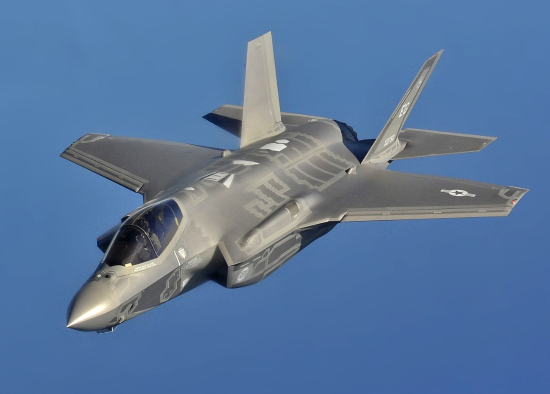
- Airspeed: Mach 1.6
- Crew: 1 Pilot
- Dimensions: 52 ft x 14.5 ft.
- Wingspan: 35 ft
- First Flight: 2006
- Manufacturer: Lockheed Martin
- Type: Combat / Fighter Jet
The lore of Navy combat planes is contagious considering there are many books and movies inspired by their antics.
Nevertheless, it’s hard to find a man braver than one willing to strap on a fighter jet or Navy bomber.
The U.S. Navy relies on combat aircraft and fighter jets to destroy enemy targets, including opposing aircraft.
Thus, Navy fighters are typically armed with the ability to attack and defend with incredible maneuverability and speed.
It’s hard to find a better example than the F-35 Lightning II.
The F-35 fighter jet is currently the favorite among the U.S. Navy for combat roles in addition to the F-18E.
The F-35 Lightning is mind-blowing fast (top speeds reach 1,200 mph) while also providing advanced avionics.
The first F-35 Lightning II was introduced in 2019, so it remains the new young gun to the Navy’s superior fleet of fighter jets.
Related Article – F-22 Vs. F-35: Top 10 Differences Between The Raptor & Lightning II
#2. F/A-18E Super Hornet
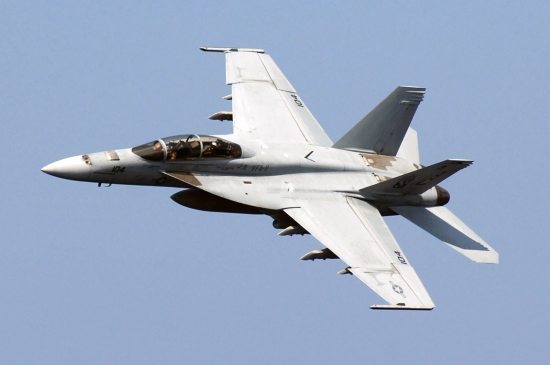
- Airspeed: 1,190 mph (1,915 km/h)
- Crew: 1 Pilot
- Dimensions: 60 ft x 16 ft.
- Wingspan: 44 ft 8.5 in
- First Flight: 1999
- Manufacturer: Boeing
- Type: Combat / Fighter Jet
The F/A-18E Super Hornet remains widely popular among the U.S. Navy despite the new kid on the block.
There are some pilots that prefer the F/A-18E for combat operations.
For this reason, it not only remains active but is the most-used plane in the U.S. Navy.
The military branch relies on the fighter jet for a variety of roles.
There are 2 types of F/A-18 fighter jets: A) the single-seat F/A-18E and B) the F/A-18F tandem-seat.
The tandem-seat version takes a lot of inspiration from the F/A-18C and D Hornet.
Nevertheless, the Super Hornet is noteworthy for its air missiles and air-to-surface weapons.
Related Article – F-16 Vs. F-18: Top 10 Differences Between The Viper & Super Hornet
#3. E-2 Hawkeye
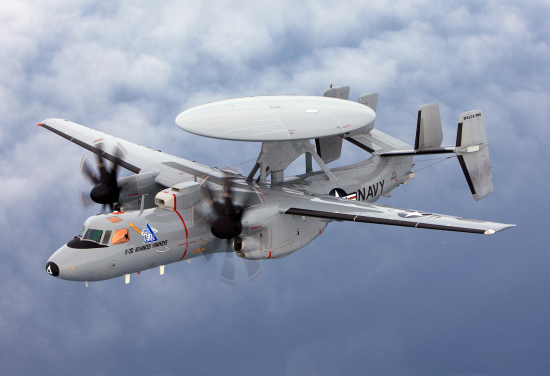
- Airspeed: 400 mph (650 km/h)
- Crew: 5 (pilot, co-pilot, radar officer, CICO, and ACO)
- Dimensions: 57 ft 9 in x 18 ft.
- Wingspan: 80 ft. 7 in
- First Flight: 1960
- Manufacturer: Northrop Grumman
- Type: Navy AEW Aircraft
The E-2 Hawkeye is known as an Airborne Early Warning (AEW) plane.
In other words, it features highly sophisticated radar systems that are able to detect and track targets outside the range of ground-based radar.
Thus, ships highly rely on Navy AEW aircraft to keep everything on board safe and protected.
Often, the U.S. Navy elects to send Airborne Early Warning (AEW) aircraft into a battle zone to conduct surveillance.
These high-tech aircraft can also monitor ground units and serve as vital communications back to headquarters.
The Navy E-2 Hawkeye dates back to 1960 and can boast numerous updates.
There is excitement surrounding the new version, the E-2Ds Hawkeye (carrying a $170 million price tag), thanks to its aerial refueling capabilities.
The new ability to refuel in the air allows mission time to now extend by 4-7 hours.
#4. Northrop Grumman EA-6B Prowler
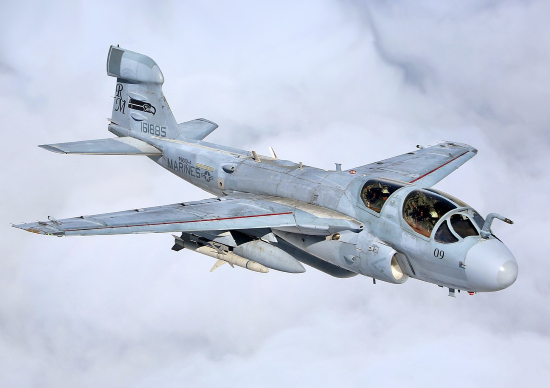
- Airspeed: 651 mph (1,048 km/h)
- Crew: 4 (1 pilot and 3 electronic countermeasures officers)
- Dimensions: 59 ft 10 in x 16 ft 8 in.
- Wingspan: 53 ft.
- First Flight: 1968
- Manufacturer: Northrop Grumman
- Type: Electronic Warfare Aircraft (Radar Jamming)
The Northrop Grumman EA-6B Prowler was another impressive design that ranks among the most unique types of Navy aircraft.
For starters, the high-tech design allowed the aircraft to deliberately interfere with enemy radar.
Once the radar is jammed, U.S. Navy and friendly aircraft and ships can proceed on targets without being detected.
The Northrop Grumman EA-6B Prowler was first introduced in the late-1960s and was retired in 2019.
The Navy began transitioning to the recent iteration in 2009, the EA-18G Growler, a modified form of the F/A-18F Super Hornet.
It’s an important accomplishment as the U.S. Navy seeks to remain ahead of the competition in aviation advancement.
Related Article – Navy Pilot Requirements
#5. C-26 Metroliner
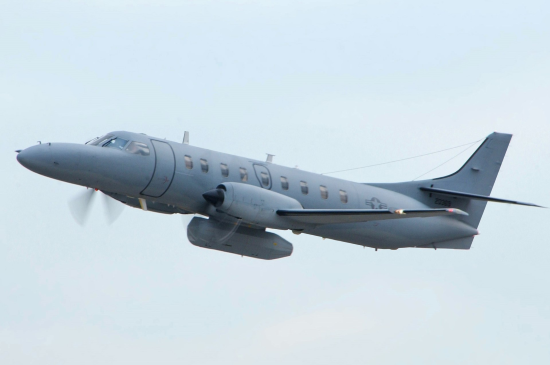
- Airspeed: 331 mph (533 km/h)
- Crew: 2
- Dimensions: 42 ft 2 in x 16 ft 10 in.
- Wingspan: 46 ft 3 in.
- First Deployed: 1998
- Manufacturer: Fairchild
- Type: Military Transport Aircraft
The C-26 Metroliner serves as important transport aircraft for the U.S. Navy.
It regularly transports passengers and cargo over long distances.
The massive cabin of the C-26 Metroliner provides a huge storage space for cargo.
Even better, these planes are equipped with enormous fuel reserves which allow them to fly in the air for long periods of time (despite hauling so much weight).
The C-26 Metroliner (and the C-130 Hercules) represent modified versions of civilian aircraft.
The Metroliner can accommodate 19 passengers and is used to train students in the Airborne Systems syllabus at the USN Test Pilot School.
#6. C-130 Hercules
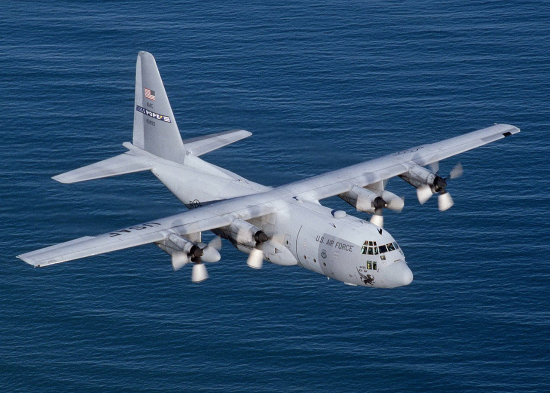
- Airspeed: 370 mph (590 km/h)
- Crew: 5 (2 pilots, 1 CSO/navigator, flight engineer, and loadmaster)
- Capacity: 42,000 lbs.
- Dimensions: 97 ft 9 in x 38 ft 3 in.
- Wingspan: 132 ft 7 in.
- First Flight: 1954
- Manufacturer: Lockheed Martin
- Type: Military Transport Aircraft
The C-130 Hercules has a long history with the military, as it dates back to 1956.
In fact, it’s the longest continuously produced aircraft currently in service.
The reliability and dependability of the C-130 Hercules are apparent not to mention worthy of the lofty name.
The airliner can host nearly 100 passengers or 72 combat troops, depending on the situation.
It’s the larger capacity option compared to the C-26 Metroliner.
The Hercules has also undergone several upgrades including a new version that requires far less takeoff distance and greater range.
The U.S. Navy typically uses the C-130 Hercules for troop and cargo transport and air-to-air refueling.
Related Article – Navy Pilot Vs. Air Force Pilot
#7. C-40 Clipper
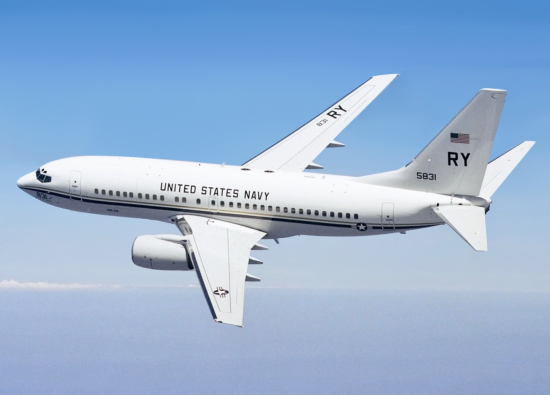
- Airspeed: 615 mph (989 km/h)
- Crew: 4 (pilot, co-pilot, crew chief, and loadmaster)
- Capacity: 121 passengers
- Dimensions: 110 ft 4 in x 41 ft 2 in.
- Wingspan: 117 ft 5 in.
- First Flight: 2000
- Manufacturer: Boeing
- Type: Military Transport VIP Airplane
The C-40A is the first new fleet logistics support aircraft ordered by the Navy in nearly two decades.
Its fuel efficiency and low environmental impact far outstrips that of its predecessor, the C9B.
The Navy uses this aircraft in three different configurations: all cargo, all passengers, or a combination of the two.
Its high-tech avionics systems and fuel capacity deem it worthy for over-water operations.
The C-40 Clipper is a highly-modified Boeing 737 that is also utilized by the U.S. Air Force.
There are several enhancements from a typical commercial airliner including strengthened wings and more durable landing gear.
Furthermore, C-40 Clippers offer auxiliary fuel tanks with the ability to range over 5,700 miles.
#8. C-20 Gulfstream
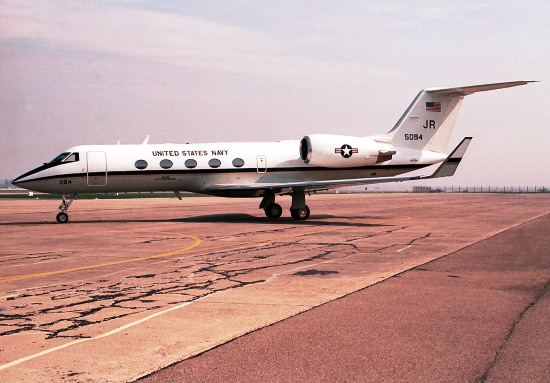
- Airspeed: Mach 0.88
- Crew: 3
- Dimensions: 88 ft 4 in x 24 ft 5 in.
- Wingspan: 77 ft 10 in.
- First Flight: 1985
- Manufacturer: Gulfstream Aerospace
- Type: Military Transport Airplane
The U.S. Navy purchased the C-20 Gulfstream for high-profile military transport for senior leadership and dignitaries.
It is the military equivalent of the Gulfstream IV, a long-range, all-weather, twin-jet aircraft built mainly for private business use.
The Navy is also working on modifications to develop the C-20G as a Range Support Aircraft for data collection.
Today, the Gulfstream remains a noteworthy addition to the extraordinary fleet of U.S. Navy aircraft.
#9. MH-53E Sea Dragon
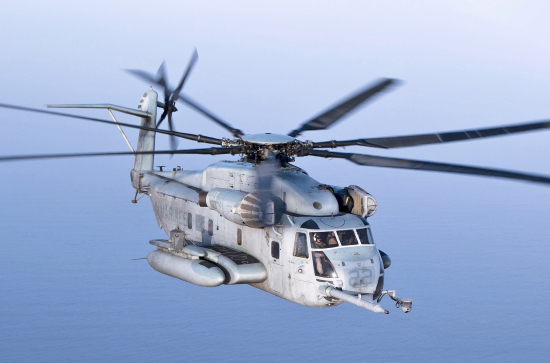
- Airspeed: 200 mph (310 km/h)
- Crew: 2 (2 pilots and 1-6 depending on mission)
- Capacity: 30 troops
- Dimensions: 99 ft x 28 ft 4 in.
- Rotor: Double (6-Blade)
- First Flight: 1974
- Manufacturer: Sikorsky
- Type: Military Minesweeping Aircraft
The Sea Dragon is another unique type of Navy aircraft.
The Navy utilizes minesweeping aircraft like the MH-53E Sea Dragon to set a clear path for friendly units.
Navy minesweeping planes are able to locate mines by sweeping gear through the water.
There are magnets attached to the gear which attract naval mines and clear waters before they can get safely navigated.
The U.S. Navy currently uses several variations of the Sea Dragon helicopter.
Currently out of production, the Navy intends to keep these helicopters in operation until 2027.
Related Article – Military Pilot Vision Requirements
#10. P-3 Orion
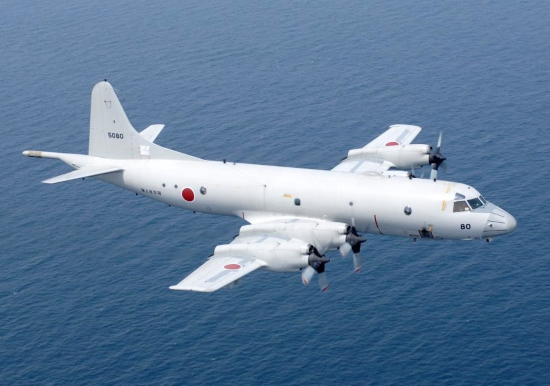
- Airspeed: 473 mph (761 km/h)
- Crew: 11
- Dimensions: 116 ft 10 in. x 33 ft 8.5 in.
- Wingspan: 99 ft 8 in.
- First Flight: 1959
- Manufacturer: Lockheed Martin
- Type: Maritime Patrol Aircraft
The P-3 Orion serves dual roles for the Navy along with the Boeing P-8.
It’s utilized as both a maritime patrol aircraft as well as for reconnaissance missions.
The P-3 Orion has a long track record that dates to the 1960s.
It’s still used in service in the Navy Reserves and is among the most reliable types of Navy aircraft you’ll find in the branch.
#11. P-8 Poseidon
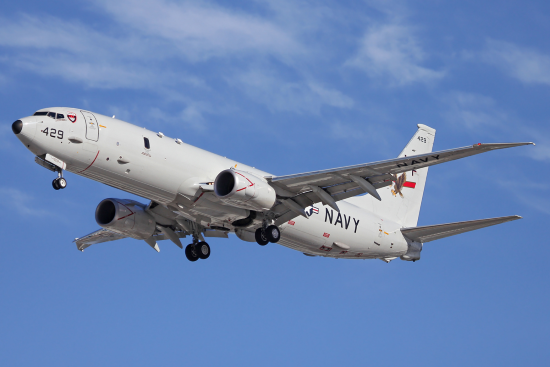
- Airspeed: 564 mph (907 km/h)
- Crew: 2 flight; 7 mission
- Capacity: 19,800 lbs.
- Dimensions: 129 ft 5 in. x 42 ft 1 in.
- Wingspan: 123 ft 6 in.
- First Flight: 2009
- Manufacturer: Boeing
- Type: Maritime Patrol Aircraft
The P-8 Poseidon is the competition Boeing presented when it introduced the model as an update to the P-3.
While the Boeing P-8 Poseidon was designed to serve as a replacement, both remain in service for several more years.
It often depends on who you ask in terms of preference.
Regardless, both types of Navy aircraft assist the military in patrolling international waters.
There are few enemies that want to mess with Navy aircraft armed with torpedoes and anti-ship missiles.
The P-8 Poseidon (like its cousin the P-3 Orion) can tackle submarines and anti-surface warfare (ASUW).
#12. SH-60 Seahawk
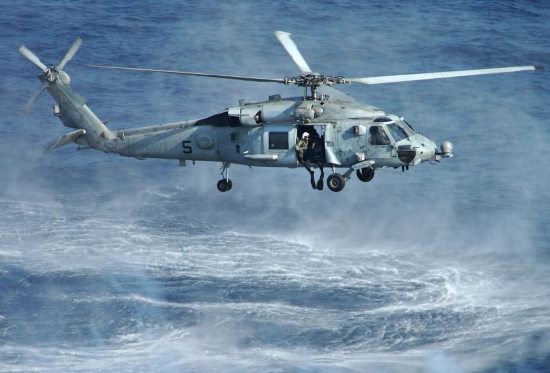
- Airspeed: 168 mph (270 km/h)
- Crew: 3-4
- Capacity: 5 passengers / 6,000 lbs.
- Dimensions: 64 ft 8 in. x 17 ft 2 in.
- Rotor: Single, 4-Blade (with tail fin)
- First Flight: 1979
- Manufacturer: Sikorsky
- Type: Utility Maritime Helicopter
The U.S. Navy leads aviation in many regards yet it has the Army to thank for the Seahawk.
The multi-purpose helicopter is inspired by the iconic Army design of the UH-60 Black Hawk helicopter.
As a result, the SH-60 Seahawk delivers some impressive features and rules the waters.
It’s capable of patrolling waters while handling anti-submarine warfare (ASW).
Related Article – Navy Aircrewman Career Details
#13. Lockheed EP-3
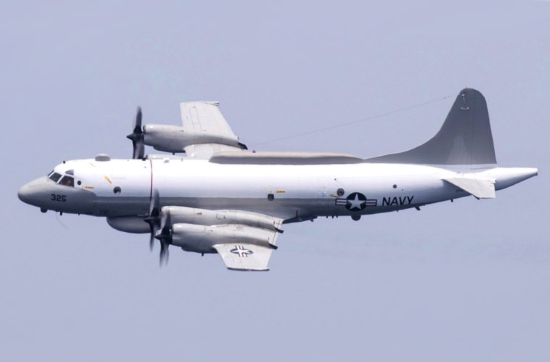
- Airspeed: 440 mph (700 km/h)
- Crew: 3
- Capacity: 19+ crew
- Dimensions: 116 ft 10 in. x 33 ft 8.5 in.
- Wingspan: 99 ft 8 in.
- First Flight: 1960
- Manufacturer: Lockheed Corporation
- Type: Military Signals Intelligence (SIGINT) Plane
The Navy trusts Signals Intelligence (SIGINT) aircraft as a means to intercept radio and radar signals.
Moreover, SIGINT can detect enemy locations which alert forces of any surprise attacks.
The technology of Lockheed EP-3 planes is noteworthy, especially since they’ve been in existence since the 1960s.
Unfortunately, the future of EP-3 aircraft is not long because the Navy plans to retire them in 2025.
The U.S. Navy – like most military branches – is starting to drift toward unmanned aircraft for certain operations.
The unmanned replacements scheduled include the MQ-4C Broad Area Maritime Surveillance (BAMS) aircraft and MQ-8B Fire Scout helicopter.
#14. E-6 Mercury
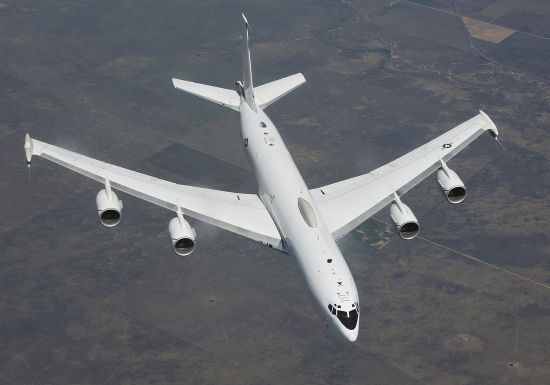
- Airspeed: 610 mph (980 km/h)
- Crew: 22
- Dimensions: 152 ft 11 in. x 42 ft 5 in.
- Wingspan: 148ft 2 in.
- First Flight: 1987
- Manufacturer: Boeing
- Type: Military Strategic Airborne Command Post Aircraft
The Navy operates Take Charge and Move Out (TACAMO) planes as communication links during warfare.
U.S. Navy TACAMO aircraft is designed as the fail-all option should nuclear warfare occur.
Thus, the aircraft keeps communication open to important decision-makers at the point of a crisis.
The Navy first deployed TACAMO planes (like the E-6 Mercury) in the late-1980s.
At the time, the Mercury replaced the Air Force’s EC-135C which was developed with the same intentions.
Today, the E-6 Mercury is only found at Tinker Air Force Base in Oklahoma and operated by Navy Fleet Air Reconnaissance Squadrons.
#15. Northrop F-5
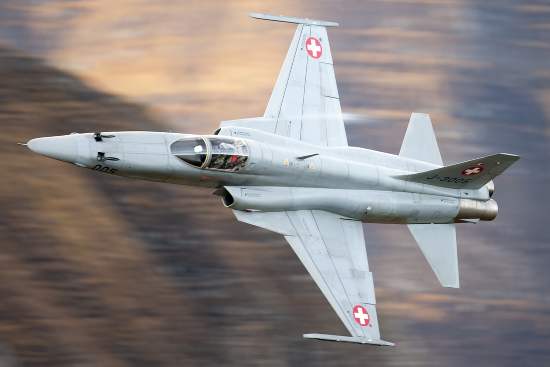
- Airspeed: Mach 1.63
- Crew: 1
- Dimensions: 48 ft 2.25 in. x 13 ft 4.5 in.
- Wingspan: 26 ft 8 in.
- First Flight: 1959
- Manufacturer: Northrop Corporation
- Type: Training Fighter Jet
The Northrop F-5 is one of the more well-known training jets for the U.S. Navy.
The Navy features a legendary aviation program including some of the finest jets ever assembled.
Moreover, Navy pilots are highly revered, which makes training jets like the F-5 noteworthy.
Additionally, the T-45 Goshawk and T-6 Texan II are considered classic Navy trainer jets.
There are many other types of Navy aircraft specifically designated for training purposes.
These include fighter jets, helicopters, single-engine planes, and twin-engine fixed-wing aircraft.
#16. F-16 Fighting Falcon
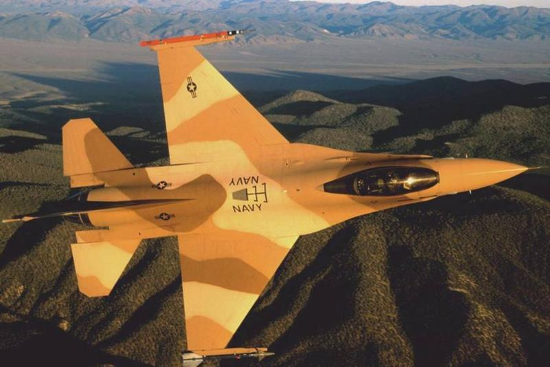
- Airspeed: Mach 1.73
- Crew: F-16A One; F-16B Two
- Dimensions: 47 ft 8 in. x 16 ft 5 in.
- Wingspan: 31 ft
- First Flight: 1974
- Manufacturer: General Dynamics
- Type: Training Fighter Jet
The F-16 Fighting Falcon is one ferocious jet.
It had a long record in duty but is now reserved for training purposes.
The trend is consistent with most Navy trainer aircraft that were previously in service.
The ability to command and master a previous icon like the F-16 is what makes the Navy aviation training program really special.
Lastly, the Navy reserves some aircraft (like the F-35 and F/A-18E/F) strictly for training purposes.
#17. T-34 Mentor Aircraft
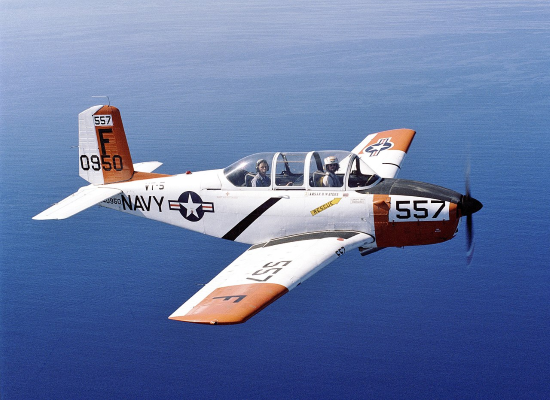
- Airspeed: 246 mph (396 km/h)
- Crew: 2
- Dimensions: 28 ft 8 in. x 9 ft 7 in.
- Wingspan: 33 ft.
- First Flight: 1948
- Manufacturer: Beechcraft
- Type: Navy Training Aircraft
The T-34 Mentor Aircraft is a unique type of Navy aircraft that new pilots will get the opportunity to control.
The single-engine military training was originally released in 1953.
Therefore, it carries an incredible tradition with the Navy and is highly respected.
Meanwhile, the U.S. Navy also designates the T-6 Texan II for similar training purposes.
- Replacing Dog Tags: 6 Things You Need to Know - June 28, 2024
- Navy OAR Test Study Guide - June 24, 2024
- 10 Best Sniper Movies of all Time - June 20, 2024
Originally posted on September 3, 2022 @ 6:20 pm
Affiliate Disclosure: This post may contain affiliate links. If you click and purchase, I may receive a small commission at no extra cost to you. I only recommend products I have personally vetted. Learn more.
